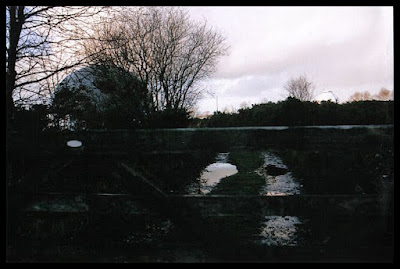This was one of those beautiful sunny winter afternoons in late December 2013. I'd been to Sidmouth Garden Centre with a friend and she suggested we take a look at the Observatory on the way back. It's somewhere that isn't easy to access without transport, and I don't drive, so I jumped at the chance...well, jump isn't exactly the right word as I was hobbling around on a walking stick at the time due to a back injury, but it's somewhere I've been wanting to visit for a long time so I was really chuffed to have the opportunity.
Originally called Hill Observatory, it was built by the scientist and astronomer Sir Joseph Norman Lockyer in 1912, as a replacement for the South Kensington Observatory, which had closed. His wife, Lady Lockyer, inherited the land where they had a house built to retire to, and it was the top part of this land that was used for the observatory; the Hill Observatory Corporation subsequently established in 1916. After his death in 1920 his son, James Lockyer, renamed it the Norman Lockyer Observatory as a tribute to his father.
Apart from the years during the two World Wars, the corporation continued until 1943 when Lady Lockyer died, bequeathing her house and land to the corporation. The house is still there but it was sold and is now a private residence.
After
being out of astronomical use for some time, the site was eventually
bought by the East Devon District Council and reopened in 1989 by Patrick Moore, a
well-known astronomer featured on a British television programme.
The site comprises three Victorian refracting telescopes and two modern
reflectors. Other features are a planetarium, a meteorological station, a
library and equipment for amateur radio reception. Operated by members
of the Norman Lockyer Observatory Society, there are open days and
lectures for visitors utilising the planetarium, an exhibition area and
lecture theatre.
The three Victorian domes are Grade II Listed Buildings.
I don't know for certain which buildings were which, as this wasn't
exactly an official visit, but by the descriptions in the listings the
Mond Dome was attached to the long building shown in these two photos and the dome itself can be seen in the photos above those.
The building for the Mond telescope was largely extended to house an exhibition centre and a large dome (seen above) for the James Lockyer Planetarium. Other facilities include more space for the Radio Society (no pun intended, lol), a kitchen & toilets. And it was again opened by Patrick Moore in 1995.
Below shows the metal door to the Mond Dome, complete with a lovely circular astrological and lunar design.
The other two domes are the Kensington Dome and the McClean Dome, both built in 1912. Their descriptions are exactly the same, therefore I don't know which one is which. Here's one with the right description...
...and the other below, with a picnic area.
Looking from that dome across to another one, which must be one of the new ones...
...seen below, along with another nearby.
Plus a couple of photos showing domes on the horizon...one on the way in and another on the way out! :)

















No comments:
Post a Comment